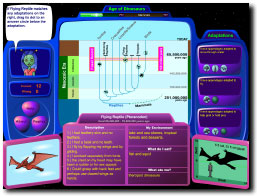 |
| In Life Preservers, players are challenged to protect Earth from invasive, alien species that threaten the planet’s natural evolution of life. Through multiple rounds of play, players learn key concepts about the evolution and adaptation of life on Earth. |
Life Preservers
OVERVIEW
Life Preservers is a National Science Foundation funded, web-based endogenous learning game designed to meet specific educational, game design, and research goals. Most notably, Life Preservers is designed to:
- teach a subset of the National Science standards on adaptation and evolution to 7th through 9th grade students;
- impart a visceral sense of the curious history of vertebrate life on Earth through storytelling, animation, and gameplay;
- be playable within a 45-minute class period;
- appeal to both boys AND girls, integrating the latest research on gender issues in game design;
- be adaptable and easily modifiable to accommodate the ongoing iterative design process;
- track detailed gameplay data for testing a number of research hypothesis.
On going research with Life Preservers examines gender, play style, and learning and how they each affect each other.
CREATIVE MERIT
Peer Reviewed Exhibitions:
- Winn, B., Heeter, C., Greene, D. Life Preservers. Exhibited at FuturePlay 2005 International Academic Conference on the Future of Game Design and Technology in East Lansing, MI, October 14, 2005.
- Winn, B., Heeter, C. Life Preservers: Playing with the National Science Standards. Exhibited at 2005 Games for Learning and Society Conference, Madison, WI. June 15-16, 2005.
Audience Reach:
- Teacher and student site available online at lifepreservers.msu.edu (launched Fall 2006)
- Approximately 1000 6th through 10th graders played Life Preservers during the research phase, Fall 2004 through Summer 2006.
Other Visibility:
- Newspaper
- “MIND GAMES: MSU lab developing new ways to learn.” Lansing State Journal. Sept. 26, 2006. (Picked up by the Associated Press and carried in newspapers around the country.) Article includes a description of Life Preservers with URL.
- Web:
SCHOLARLY CONTRIBUTIONS
Peer Reviewed Book Chapter
- Heeter, C., Winn, B. Implications of Gender, Player Type and Learning Strategies for the Design of Games for Learning. To appear in Beyond Barbie to Mortal Combat: New perspectives on games, gender, and computing. MIT Press, Cambridge, MA. In press.
Peer Reviewed Journal Articles
- Winn, B., Heeter, C. Resolving Conflicts in Educational Game Design Through Playtesting. Innovate Journal of Online Education. Volume 3, Issue 2, December 2006/January 2007.
Peer Reviewed Publication in Conference Proceedings
- Heeter, C., Winn, B., Greene, D. Theories Meet Realities: Designing a learning game for girls. Proceedings of the DUX (Designing for User eXperience) Conference, San Francisco, November, 2005.
- Heeter, C., Winn, B. Gender, Playstyle, and Learning: Construction In-Game Measures of Playstyle. Proceedings of the FuturePlay International Academic Conference on the Future of Game Design and Technology, East Lansing, MI, October, 2005.
- Heeter, C., Winn, B., Egidio, R. and Mishra, P. Girls as Space Game Designers: Extreme baseline research, Proceedings of the DUX (Designing for User eXperience) Conference, San Francisco, June, 2003.
Peer Reviewed Conference Papers and Posters
- Winn, B., Heeter, C., Life Preservers: Playing with Evolution. Five Minutes of Fame Presentation given at New Media Center Conference, Cleveland, OH, June 9, 2006.
- Heeter, C., Winn, B. Using Player Research to Mediate Battles Between Pedagogy, Science, & Fun. Presented at the Game Developers Conference (GDC) 2006 Serious Games Summit. March 20, 2006.
- Heeter, C., Winn, B., Caywood, J. Gender, Play Style, and Learning. Poster presented at National Science Foundation’s 2006 Division of Human Resource Development (HRD) Joint Annual Meeting (JAM), Washington, D.C., March 16, 2006.
FUNDING
- Gender, Playstyle, and Learning, July 2005, NSF, $118.925, C. Heeter PI, B. Winn Co-PI, Funded.
- Gender and Learning from Games: Tree of Life Critter Capture, National Science Foundation, $98,000, C. Heeter, B. Winn, R. Egidio, D. Greene. Funded. November, 2004.
ROLE
The design team consisted of Carrie Heeter as project leader and learning architect, myself as lead game designer and programmer, Darcy Drew Greene as art director, Patrick Shaw as interface and interaction designer, Amanda Flowers as artist, Randy Russell as science advisor, Jillian Caywood as research assistant, and Timothy O’Brien, Greg Mercer, and Hai Min as the sound design team.
VIEW THE WORK
Life Preservers is available online at http://lifepreservers.msu.edu.
See also the extensive teacher information site that describes science backstory and learning from the game, at http://www.gel.msu.edu/lifepreservers/.
|